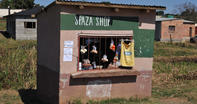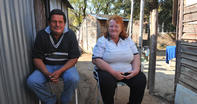Unpredictable Income Streams
Being dependent on short-term casual work is risky. By its very nature, it ebbs and flows unpredictably. So some of the other strategies families in poorer communities will use to survive include starting up small businesses at home. Others will rent out rooms or backyard dwellings to lodgers.

Alternatively, they might beg or rely on gifts from within the community, borrow, or make some kind of credit arrangement. (Ironically, it is this tendency to borrow, as one of the many idiosyncratic coping strategies that the poor use to tide them through the hungry season, that often hides the true extent of food insecurity in the urban context – it is hard to see how people cope or not, so it is difficult to measure how vulnerable or buffered they are.) Some families might try growing their own food and tending livestock.
Paradoxically, it is indicated that in some SADC countries access to social grants actually erodes communities’ efforts to diversify their strategies for surviving. However, when cash-strapped families do get a bit of money, they tend to spend it on meeting their basic consumption needs first, writes development economist Dr Stephen Devereux from the Institute of Development Studies in Brighton in the UK.
Next, they will budget for health or schooling needs, an investment in social capital that may not bring short-term returns, but can certainly prove fruitful in the long run. If there is anything left over after that, they are willing to plough some resources into their neighbours or community.
The latter, argues Devereux, is strategic: it is about supporting others, but also builds up a basis for ‘reciprocal claims’ later – when the family is running low on resources, they can expect something in kind.
At the informal camp of Sonskynhoekie near Pretoria, Cornelia’s (the camp matriarch’s) relationship with Annetjie (the owner’s daughter-in-law) typifies this – whether the exchange is in favours (buying food, for instance, or managing the tuck shop) or sharing meals, it is another avenue for accessing resources that others in the Sonskynhoekie community do not have.
This seems to be typical, particularly for people living in poorer communities. ‘Substantial numbers of people rely to some extent on informal coping strategies to acquire food,’ writes Dr Bruce Frayne and others in a report for the Development Bank of Southern Africa, but might find themselves ‘often getting too little and with limited diversity from these sources (which include borrowing, sharing meals with neighbours and growing food)’.
Investing Left Over Cash
Once a family has met its basic and most important needs, if there is still some cash left over after this, they will tend to invest in something that could become a means of income, a source of alternative livelihood. So if a family has got some extra money, they may choose to somehow provide food for the neighbour’s child, before investing it in supplies to stock up a food garden in their backyard.
Bear in mind the risks associated with investing that small but critical bit of capital in setting up a secondary industry at home to generate another income stream. If a family has to choose between starting up a small tuck shop to sell some of the basics to passersby, or setting up a food garden, they might choose the former option.
Even though the stock on a tuck shop’s shelves does not usually consist of healthy green peppers, red cabbage or plush spinach leaves, it is a lot safer as far as investments go. Packets of chips, biscuits or cans of cola have a long shelf life, can withstand more handling without perishing and are usually more desirable and accessible for a hungry traveller.
Combined Income

With Cornelia bartering her labour with the care centre owner, and her partner Kobus’s income from begging at the lights or the odd job he will get from time to time, the two make for a fairly well-to-do double-income unit in this neck of the woods: she gets their board and lodging settled, Kobus brings in money so they can still access the cash economy.
The combined ‘income’ means Cornelia (who seems to manage the cash that Kobus brings home) can afford the otherwise expensive cable she needed in order to run electricity from the main house to her shack. Few other shacks are on the grid.
This keeps the bedside light burning all day (with only one window, the shack is cast into a deep gloom even at the height of the day), and means she can get her fix of soapies.
She can cook food, although she does not have a fridge for storage purposes. In spite of a kitchen packed neatly into the entrance of the rectangular shack – stacked with its cups, glasses and cereal jars – Cornelia says she does not eat breakfast or lunch. ‘I drink lots of Coke because it keeps me full. People call me Tannie Coke,’ she chuckles with a dry amusement. ‘Hulle spot met my, “Jaaa, Auntie Coke”.’ (‘They joke with me, “Ja, Auntie Coke”.’).
In the evening she will cook meat – mince, wors or something – enough for her and Kobus, and a bit left over for a friend of hers to eat the next morning. Sometimes, the owner Oom Hans will also ask for some. But occasionally Cornelia will eat with Annetjie’s family.
Reciprocity is Typical
Again, this kind of swings-and-roundabouts reciprocity is typical. Communities have various ways of sourcing food, as diverse as the lifestyle strategies at times.
Naturally, there are the formal sources of food – supermarkets, take-aways and restaurants – but then there are the meals shared with neighbours and other households, food supplied by neighbours, borrowed food, food from community kitchens, some may grow it, others may get food remittances, and others still, food aid.
There is an ebb and flow of pantry resources here that does not seem to get tallied up for formal repayment. It is much more fundamental than suburban housewives borrowing a cup of sugar for a Sunday afternoon cake bake, but the principles are probably the same: share and share alike.
Food trickles where it is needed, with the assumption of an informal quid pro quo when the time comes. When one family has, it shares; when it does not, it receives.
By Leonie Joubert